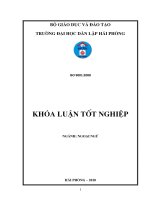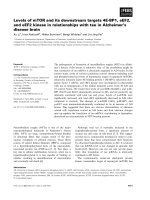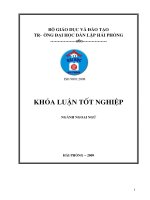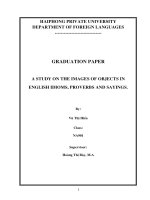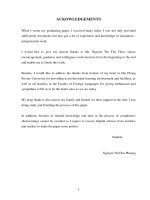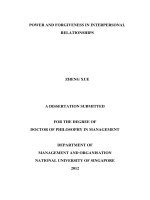English idioms, proverbs and sayings relating to relationship
Bạn đang xem bản rút gọn của tài liệu. Xem và tải ngay bản đầy đủ của tài liệu tại đây (921.04 KB, 63 trang )
1
Bộ giáo dục và đào tạo
Tr-ờng đại học dân lập hảI phòng
o0o
Khóa luận tốt nghiệp
Ngành ngoại ngữ
HảI phòng 2009
ISO 9001:2008
2
Hai phong private university
foreign languages Department
o0o
Graduation paper
English idioms, proverbs and sayings
relating to relationship.
By :
NguyÔn ThÞ Thu H-êng
Class : NA901
Supervisor :
Hoµng ThÞ B¶y, M.A
Hai phong - 2009
3
Bộ giáo dục và đào tạo
Tr-ờng đại học dân lập hảI phòng
Nhiệm vụ đề tài tốt nghiệp
Sinh viên : Mã số :
Lớp : Ngành :
Tên đề tài :
4
Nhiệm vụ đề tài
1. Nội dung và các yêu cầu cần giải quyết trong nhiệm vụ đề tài tốt nghiệp
( Về lí luận, thực tiễn, các số liệu cần tính toán và các bản vẽ ).
2. Các số liệu cần thiết để thiết kế, tính toán.
3. Địa điểm thực tập tốt nghiệp.
5
Cán bộ h-ớng dẫn đề tài tốt nghiệp
Ng-ời h-ớng dẫn thứ nhất :
Họ và tên:
Học hàm, học vị:
Cơ quan công tác:
Nội dung h-ớng dẫn:
Ng-ời h-ớng dẫn thứ hai :
Họ và tên:
Học hàm, học vị:
Cơ quan công tác:
Nội dung h-ớng dẫn:
Đề tài tốt nghiệp đ-ợc giao ngày tháng . năm 200
Yêu cầu phải hoàn thành xong tr-ớc ngày tháng năm 200
Đã nhận nhiệm vụ Đ.T.T.N
Sinh viên
Đã giao nhiệm vụ Đ.T.T.N
Cán bộ h-ớng dẫn Đ.T.T.N
Hải Phòng, ngày tháng .năm 200
Hiệu tr-ởng
Gs.ts.ng-t trần Hữu Nghị
6
Phần nhận xét tóm tắt của cán bộ h-ớng dẫn
1. Tinh thần thái độ của sinh viên trong quá trình làm đề tài tốt nghiệp
2. Đánh giá chất l-ợng của Đ.T.T.N ( So với nội dung yêu cầu đã đề ra trong
nhiệm vụ Đ.T.T.N trên các mặt lí luận, thực tiễn, tính toán giá trị sử dụng,
chất l-ợng bản vẽ )
3. Cho điểm của cán bộ h-ớng dẫn :
( Điểm ghi bằng số và chữ )
Hải Phòng, ngày. tháng năm 2009
Cán bộ h-ớng dẫn chính
( Họ tên và chữ kí )
7
Nhận xét đánh giá
của cán bộ chấm Phản biện đề tài tốt nghiệp
1. Đánh giá chất l-ợng đề tài tốt nghiệp về các mặt thu thập và phân tích
số liệu ban đầu, cơ sở lí luận chọn ph-ơng án tối -u, cách tính toán
chất l-ợng thuyết minh và bản vẽ, giá trị lí luận và thực tiễn của đề tài.
2. Cho điểm của cán bộ phản biện
( Điểm ghi bằng số và chữ )
Hải Phòng, ngày tháng.năm 2009
Ng-ời chấm phản biện
8
ACKNOWLEDGEMENTS
* * *
In the completion of the graduation paper, I received so much help and advice
from many people that my indebtedness to them is beyond words.
First and foremost, I owe a tremendous debt of gratitude to my supervisor,
Hoang Thi Bay, M.A , for her warmth and understanding which she graciously
gave me, for her energy and time which she consumed to improve and polish my
drafts, and for her criticism and encouragement, the lack of which would render
this paper impossible.
Then, I would like to thank other teachers of department of Foreign Language
for their useful lessons and materials during 4 years which construct the
background of the paper.
Last but not least, I wish to express my heart - felt gratitude to my family and
my friends, who always encouraged and supported me in the process of
completing the paper.
Hai phong, 2009
NguyÔn ThÞ Thu H-êng
9
TABLE OF CONTENTS
TABLE OF CONTENTS 1
PART I: INTRODUCTION 3
1. Rationale 3
2. Scope of the study 4
3. Aims of the study 4
4. Method of the study 5
5. Design of the study 5
PART II: DEVELOPMENT 7
CHAPTER I: GENERAL THEORetICAL BACKGROUND 7
I. Idioms versus proverbs 7
1. An overview of proverb 7
1.1. Definition of proverb 7
1.2. Some common features of proverb 10
2. An overview of idiom 10
2.1. Definition of idiom 10
2.2. Some common features of idiom 12
3. The distinction between idioms and proverbs 13
3.1. English idioms and proverbs 13
3.2. Vietnamese idioms and proverbs 14
4. Similarities and differences between English and Vietnamese idioms
and proverbs 15
4.1. Similarities 15
4.2. Differences 17
10
CHAPTER II: ENGLISH AND VIETNAMESE IDIOMS, PROVERBS
and sayings RELATING TO RELATIONSHIP 19
I. The importance of relationship in life 19
II. Subcategories of idioms and proverbs relating to relationship 22
1. Proverbs and idioms relating to friendship 22
1.1. Definition of friendship 22
1.2. Proverbs and idioms relating to true friendship 25
1.3. Proverbs and idioms relating to bad friendship 32
1.4. Advice for friendship 35
2. Proverbs and idioms relating to love 37
2.1. Definition of love 37
2.2. Proverbs and idioms relating to the challenges of love 39
2.3. Proverbs and idioms relating to the power of love 43
3. Proverbs and idioms relating to family 46
3.1. Proverbs and idioms relating to relationship between husband
and wife 46
3.2. Proverbs and idioms relating to relationship between parents
and children 49
CHAPTER III: SOME DIFFICULTIES FOR LEARNER OF ENGLISH
WHEN STUDYING IDIOMS AND PROVERBS 52
I. Some difficulties in studying idioms and proverbs 52
II. Suggested solutions 52
PART III: CONCLUSIon 54
REFERENCE 55
11
PART I: INTRODUCTION
1. Rationale
Nowadays, English is the most widely used in the world and plays an important
role together with the development of society and technologies. English is not
only the effective means of communication but also show its progressive effects
in many aspects of life.
Practically, study on the similarities and differences between the two languages
and cultures English and Vietnamese has been one of my concerns when
studying English at university. It is clear that there are many differences
between the two languages of as those in grammar, lexicology, translation,
phonetic and so on. However there still exists plenty of similarities and
differences between English and Vietnamese that can be demonstrated through
metaphorical meaning especially in literature, idioms and proverbs expression.
This study of English idioms and proverbs has been traditionally associated with
the study of literature, the use of idioms and proverbs is not restricted to this
kind of language. A good understanding of how idioms and proverbs are used in
everyday language is not only important for students of English to increase our
vocabulary, but also to understand new and original idioms and proverbs when
we hear or speak them.
However, what I want to express here it that idioms and proverbs are the genius
of national language that is the key to help learners know more about nation, as
well as custom and culture of each country all over the world. Therefore, it is a
must to me to study idioms and proverbs related to relationships that have made
a deep expression on me for a long time because, I myself find it so interesting
that the relationships not only reflect the concepts but also refer the
characteristic of person and society. Most languages make use of idioms and
proverbs but the way individual words used varies from one language to another
and each languages has its own system and that they cannot always transfer the
metaphorical use of a word from one language to another.
12
Importantly, idioms and proverbs help learners see the interest, the beauty as
well as the culture color of language which help learners use and understand
correctly and clearly. I hope that learners will understand about idioms and
proverbs in English especially idioms and proverbs relating to relationship that
is also the main reason motivating me to carry out this research.
2. Scope of the study
During the study process, I have been attracted by - English idioms, proverbs
and expression about relationship. Idioms and proverbs are a treasure of each
country and all that I know about them is very little because of its immense
number. Due to time allowance and limited knowledge, I cannot cover all
idioms and proverbs on these issues but only focus on idioms and proverbs
related to relationship, here is a sample of discussing on them :
- The importance of relationships in life
- Subcategories of idioms and proverbs relating to relationship, such as :
friendship, love, and family.
3. Aims of the study
Being aware of the fact that idioms and proverbs are extremely difficult topic
and merely well- understood by foreign English learners and even if native
speakers of English who take the idioms and proverbs for granted because when
they use idioms and proverbs, they don’t know what they are using them,
however, appreciate the idioms and proverbs associated to attitude and behavior
of the speakers. So when they hear foreigners make grammatical or
pronunciation mistakes, they are quite willing to accept and understand them.
But if inappropriate idioms and proverbs are used then, they might not
understand what that person means and that leads to a misunderstanding and
boring conversation. Therefore, my research is aimed at :
- Giving the knowledge of relationship idioms and proverbs.
- Distinguishing different kinds of relationship idioms and proverbs.
13
- Raising the learner’s awareness of the existence of relationship idioms
and proverbs and the effects using them on communication.
- Helping the learners use right idioms and proverbs in right situation.
- Comparing and contrasting the meaning and usage of some certain
English idioms and proverbs about relationship with Vietnamese ones to
find the similarities and differences, so that readers can understand more
about culture, society, as well as people of these two countries.
4. Method of the study
In order to learn English idioms and proverbs relating to relationship and
Vietnamese equivalence better, with a hope that learners could see the role of
idioms and proverbs in life, the following methods are used in the studying
process:
- First, having discussion with the supervisor, experts and friends
- Besides, idioms were collected from dictionary to get valuable knowledge
for this paper.
- Furthermore, information related to the research paper from websites was
also looked into in order to complete this research successfully.
- Finally, I will analyze and compare these idioms and proverbs.
5. Design of the study
This paper provides a clear organization consisting three main parts that help an
easy exploration and practical benefits gained for readers as well.
Part 1: Introduction
Part 2: Development
Chapter 1: Theoretical background of English and Vietnamese idioms
and proverbs : some definitions of idioms and proverbs, how idioms
versus proverbs, the differences and similarities between English and
Vietnamese idioms and proverbs, the popularity of idioms and proverbs.
14
Chapter 2: Relationship idioms and proverbs in English and Vietnamese
equivalences. In this chapter some certain idiom and proverb are analyzed
according to subcategories of idioms and proverbs relating to relationship.
Chapter 3: Some difficulties for learner of English when studying idioms
and proverbs
Part 3: Conclusion
Conclusion which restates the knowledge mentioned through three chapters
above.
15
PART II: DEVELOPMENT
CHAPTER I: GENERAL THEORetICAL BACKGROUND
I. Idioms versus proverbs
Before researching to detail the use and the meaning of idioms and proverbs
related to relationship, it is important to understand the history and the use of
idioms and proverbs in daily life. Idioms and proverbs are considered as special
units of each language. They reflect honestly and exactly history, experience,
spiritual values, religious opinions and of people. So what is idiom, proverb?
How can we distinguish between them? And what are differences between
English and Vietnamese idioms and proverbs?
1. An overview of proverb
1.1. Definition of proverb
Proverbs are used by speakers for a variety of purposes. Sometimes they are used
as a way of saying something gently, in a veiled way (Obeng 1996). Other times,
they are used to carry more weight in a discussion, a weak person is able to
enlist the tradition of the ancestors to support his position. Proverbs can also be
used to simply make a conversation/discussion more lively. In many parts of the
world, the use of proverbs is a mark of being a good orator.
The study of proverbs has application in a number of fields. Clearly, those who
study folklore and literature are interested in them, but scholars from a variety of
fields have found ways to profitably incorporate the study proverbs. For
example, they have been used to study abstract reasoning of children,
acculturation of immigrants, intelligence, the differing mental processes in
mental illness, cultural themes, etc. Proverbs have also been incorporated into
the strategies of social workers, teachers, preachers, and even politicians.
"Where there’s a will, there’s a way." When you hear or read the words just
cited, you will readily recognize that you have encountered a proverb. You
should also find it quite easy to recall additional instances of this literary or,
16
perhaps better, protoliterary genre. Does this mean that you (or anybody else)
can easily say what proverbs are? Hardly so, and numerous proverb scholars
have in fact despaired of the task of defining the familiar subject matter of their
expertise. In Archer Taylor's formulation of 1931, "the definition of a proverb is
too difficult to repay the undertaking[…]. An incommunicable quality tells us
this sentence is proverbial and that is not" (The Proverb 3). In a well-informed
encyclopaedia article of 1994, Peter Grzybek still concludes: "There is no
generally accepted definition which covers all specifics of the proverbial genre"
(Simple Forms 227). Recognizing the contested character of all expert
definitions, Wolfgang Mieder performed the interesting experiment of asking
fifty-five educated nonexperts to write their definition of a proverb on a piece of
paper. The following "composite definition" is based on words that occur "from
four to twenty times in the collected definitions": a proverb is "a phrase, saying,
sentence, statement, or expression of the folk which contains above all wisdom,
truth, morals, experience, lessons, and advice concerning life and which has
been handed down from generation to generation" (Proverbs Are Never out of
Season 24).
Theoretically, there are a lot of different ways to define what is proverb.
A proverb is a short saying or sentence that is generally known by many people.
The saying usually contains words of wisdom, truth or morals that are based on
common sense or practical experience. It is often a description of a basic rule of
conduct that all people generally follow or should follow. Proverbs can be found
in all languages.
For instance :
Every day is not Saturday
( S«ng cã khóc ng-êi cã lóc )
Man proposes, God disposes
17
( M-u sự tại nhân, hành sự tại thiên)
Paul Hermadi and Francis Steen make it clearly by considering proverbs
brief, memorable, and intuitively convincing formulations of socially
sanctioned advice.
As most proverbs have their origin in oral tradition, they are generally
worded in such a way as to be remembering easily and tend to charge little
from generation to generation, so much so that sometimes their specific
meaning is no longer relevant. For instance, the proverb Penny wise, pound
foolish is a holdover from when the America was a British colony and used
the pound as currency. Proverbs function as Folk wisdom, general advice
about how to act and live. And because they are folk wisdom, they are often
strongly reflected the cultural values and physical environment from which
they arise. For example, island cultures such as Hawaii have proverbs about
the sea; Eastern cultures have proverbs about elephants; and American
proverbs, many collected and published by Benjamin Franklin, are about hard
word bringing success. Proverbs are used to support arguments, to provide
lessons and instruction, and to stress shared values.
The concept of proverb is, however, a bit different in Vietnamese. Từ điển
tiếng Việt defines proverb as short statements, often expressed with rhythm,
which sum up knowledge, life experience and moral lessons of people.
In Từ điển thành ngữ, tục ngữ Việt Nam Nguyễn Lân states Tục ngữ là
những câu nói hoàn chỉnh, có ý nghĩa trọn vẹn, nói lên hoặc một nhận xét về
tâm lý, hoặc một lời phê phán, khen hay chê, hoặc một câu khuyên nhủ hoặc
một kinh nghiệm về nhận thức tự nhiên hay xã hội.
For example:
All lay loads on the willing horse
18
(Ng-êi kh«n nhäc lo, ®øa d¹i ¨n no l¹i n»m)
All men do not follow in the footsteps of their forbears
(Cha mÑ sinh con trêi sinh tÝnh)
According to Pham Van Binh, “A proverb is a complete sentence expressing
an idea of comment, of experience, of morality, of justice or of criticism draw
from the human life” .
1.2. Some common features of proverb
Proverbs are passed down through time with little change in form.
Proverbs are often used metaphorically and it is understanding their
metaphorical nature that we can unravel their meaning. While “ a stitch in
time saves nine”, “ don’t count your chickens before they’ve hatched”,
“don’t throw the baby out with the bathwater” are common proverb, few
of us stitch clothes, count the chickens, or throw out bathwater.
Proverbs often make use of grammatical and theoretical devices that
help to make them memorable, including alliteration, rhyme, parallel
structure, repetition of key words or phrases, and strong imagery.
2. An overview of idiom
2.1. Definition of idiom
It is important to recognize that idioms are not only colloquial expression as
many people believe. Idioms as a special form of language that carry a large
amount of cultural information, such as history, geography, religion, custom,
thinking pattern and so on. They appear in formal style, in slang, in poetry, …
To research idiom, first of all, we must understand what is idiom. This is the old
theme that we discuss it. Because to define the idiom exactly and popular
accepted definition is a difficult question. In the definition of idioms, some
19
scholar emphasis on the words quantity of structure in idioms. That is to say,
how many language units to constitute the idioms? Is it except the phrases,
words group, and words or sentences also can make up to the idioms? Others
emphasize the single meanings of idioms, it refers that the idioms meaning is
arbitrary. The idioms meaning can not be synthesized or cut apart. Different
people hold the different opinions on the definition of idioms; they have
different focal point on the definition of idioms. So we must understand the
definition of idioms exactly through the research. Although we are unlikely to
give an ideal definition to the idioms; but we should give a better definition of
idioms before the research.
In Vietnamese Dictionary, they say about idiom as follow:
Thành ngữ là một tập hợp từ đã quen dùng mà nghĩa th-ờng không giải
thích đ-ợc một cách đơn giản bằng nghĩa th-ờng của các từ tạo nên nó.
And according to the Oxford Learners Dictionary:
An idiom can be defined as a number of words which when taken together,
have a different meaning from the individual meaning of each word.
And another definition of idiom:
Idioms are words, phrases, or expressions that cannot be taken literally. In
other words, when used in everyday language, they have the meaning other than
the basic one you would find in the dictionary. Every language has its own
idioms. Learning them males understanding and using a language a lot easier
and more fun!
And sometimes idiom is defined as a phrase, construction, or expression that is
understood in a given language. This expression ha a meaning that differs from
typical syntactic patterns or that differs from literal meaning of its parts taken
together.
In fact, this is what can make idioms all the more confusing.
For example, the learner may know the words get and goat, and wonder why she
20
doesn’t understand the sentence “You get my goat” . In fact, she has little chance
of guessing, out of context, that it means “You irritate me”
Or other example:
“break the leg”
- literal meaning : someone’s leg is broken and he or she should
go to the doctor afterwards to get it fixed.
- Idiomatic meaning : do your best and do well. Often, actors tell
each other to “break the leg” before they go out the stage to
perform.
The definitions of idioms are many in our society. In my opinion, the idioms
consist of set phrases and short sentences, which are peculiar to the language in
question and steeped in the national and regional culture and ideas, thus being
colorful, forcible and thought-provoking. Strictly speaking, idioms are
expressions that are not readily understandable from their literal meanings of
individual constituents. In a broad sense, idioms may include colloquialisms,
catchphrases, slang expressions, proverbs and so on.
2.2. Some common features of idiom
There are many different definitions of idiom; however, we will find some
similarities between them.
An idiom is a multiword expression. Individual components of an idiom
can often be inflected in the same way individual words in a phrase can be
inflected. This inflection usually follows the same pattern of inflection as
the idiom’s literal counterpart.
Example: “Have a bee in one’s bonnet”
He has bee in one’s bonnet.
An idiom behaves as a single semantic unit
21
- It tends to have some measure of internal cohesion such that it can
often be replaces by a literal counterpart that is made up of a single
word.
Example: kick the bucket = die
- It resists interruption by other words whether they are semantically
compatible or not.
Example: pull one’ leg
* pull hard on one’s leg
* pull on one’s left leg
- It resists reordering of its component parts.
Example : let the cat out of the
* the cat got left out of the bag
An idiom has a non-productive syntactic structure. Only single particular
lexemes can collocate in an idiomatic construction. Substituting other
words from the same generic lexical relation set will destroy the idiomatic
meaning of the expression.
Example: eat one’s words
* eat one’s sentence
It is syntactic anomalous. It has unusual grammatical structure.
Example: by and large
3. The distinction between idioms and proverbs
3.1. English idioms and proverbs
22
If you say: "The cat is out of the bag" instead of "The secret is given away,"
you're using an idiom. But "An apple a day keeps the doctor away" is a proverb.
Proverbs are old but familiar sayings that usually give advice unlike idioms.
Friedrich Seiler (1939) presented an important definition for proverb. He defined
proverb as follows: "The prominent, articulated, advisory, and free speeches that
are current in people's language."
The proverb is a complete sentence with a firm structure that is based on an
unchangeable foundation, like “where there's a will there's a way”, or “one who
seeks will find”. Proverbs represent a complete piece of information because
they can occur as a sentence. They are meaningful by themselves.
In contrast, idioms are not syntactically independent because they can not
always occur as full sentences, but as a part of a sentence. As it was said, the
difference between proverb and idiom pertains to their form, structure, and
function. Contrary to the proverbs, idioms are the general and current phrases
that must be substituted in sentences so as to obtain a complete sense. These
phrases can change according to time adverb, subject, and object. Explanation of
an idiom is possible in the sentence with some additions. In other words the
meaning of sentence is not perceived from its component words. The idioms
carry the substance of speech. They must be used in a complete idiom.
3.2. Vietnamese idioms and proverbs
From Pham Van Binh’s point of view, proverbs are section of folklore, that is,
they are a “Complete work of literature” . Therefore, proverbs have all the
fundamental functions of literature such as the apprehension, aesthetic, and
education and so on. On the contrary, idioms are only section of language and an
idiom alone cannot express an idea completely, so it equals to word only. Hence,
they do not have functions as proverbs do and are often used to replace words so
that the expression effect of the sentient can be strengthened.
23
Nguyen Dinh Hung, another Vietnamese scholar, has approached a more
detailed distinction between them through the following table:
Distinctive features
Idiom
Proverb
Grammatical structure
A fixed phrase equivalent
to a word
Complete sentene
Literal function
The aesthetic only
The apprehension
The aesthetic
The education
Logical though form
Expressing concept and
generalizing individual
phenomena.
Expressing judgment,
affirming attributive
phenomena.
Function of language
forms
Noun denotation function
through words
Language attribute
phenomena
Information function
under consciousness
Social, cultural and
spiritual consciousness
phenomena of humans
4. Similarities and differences between English and Vietnamese idioms and
proverbs
4.1. Similarities
English- Vietnamese bilingual history is long, including a large number, of
idioms and proverbs; however, we can see some common features of both two
countries idioms and proverbs.
The first commonality is that both idioms and proverbs are implicit, humorous,
24
serious, refined and particular. They are not only compendious, but also vivid.
They can give somebody a kind of beautiful enjoyment. Because of geography,
history, religious belief, living custom, etc…the difference of the English -
Vietnamese idioms is not bearing the weight of the people’s national culture
characteristic and culture information. They are linked to cultural tradition
closely so they are inalienable.
Secondly, we also find that many English and Vietnamese idioms and proverbs
have the same meaning, awareness as well as method presenting although they
still remain national specific characteristics. Because of people being in the
emotion, there is similarity in respect of going through in the impression of
objective things and the society etc…These literal meaning of idioms and
proverbs in the English- Vietnamese ones and the image meaning are the same
or approximate. It is the same to imply the meaning, that is to say, the cultural
information that the literal meaning of this kind of idiom and image meaning
express is the same, can translate each other.
For example:
- Xa mÆt c¸ch lßng.
(Out of sight, out of mind)
Two idiom literal meanings and image meaning approximate, difference slightly,
imply meaning to be the same, the image meaning is mutually translated.
Thirdly, an English and Vietnamese proverb can consist of an idiom. For
example, Vietnamese idiom “ Chång yªu, xá ch©n lç mòi” consists of idiom “
xá ch©n lç mòi” , or idiom “ B×nh ch©n nh- v¹i” in proverb “ Ch¸y nhµ hµng
xãm, b×nh ch©n nh- v¹i”. We also see the same phenomenon in English proverb.
The English Proverb “ Don’t put all your eggs in one basket”, for instance, has
idiom “ put all one’s egg in one basket”, or the proverb “ Birds of a feather”
includes idiom “ birds of the feather”.
25
Another similarity is that both Vietnamese and English people can break
structure of given proverb or slightly change it to express effectively their
purpose in communication. For example: Vietnamese has changed proverbs Ăn
nên đọi, nói lên lời and Cái khó ló cái khôn into Ăn không nên đọi, nói
không lên lời and Cái khó ló cái khôn. It is the same in English, people break
the structure of proverb Man proposes, God disposes in the way of replacing
the noun-pair Man- God by another one the writer- the reader , so it turns
into The writer proposes, the reader disposes. This change creates a new
proverb which is suitable for their mentioned topics. Or replacing the verb do
in Never put off until tomorrow what we can do today by verb eat or buy
to make their words more humorous and effective.
4.2. Differences
It is the differences in the condition and society that create particular character
and culture of each nation; therefore, English and Vietnamese proverbs are quiet
difference from each other.
Firstly, proverbs on life experience, weather, and nature occupying a
considerable part in the store of Vietnamese proverb present clearly particularity
of agricultural inhabitants who connect closely to wet rice cultivation. For
example :
Tốt giống, tốt má, tốt mạ, tốt lúa.
Muốn giàu nuôi trâu cái, muốn lụi bại nuôi bồ câu.
Đầu năm s-ơng muối, cuối năm gió nồm.
It is difficult to find English equivalent proverbs because English proverbs
mostly reflect rather social relationship than natural one and work experience.
Secondly, anti-feudalism and class struggle spirits is expressed clearly and
drastically in Vietnamese proverbs through subtle, profound, bitter and daring
